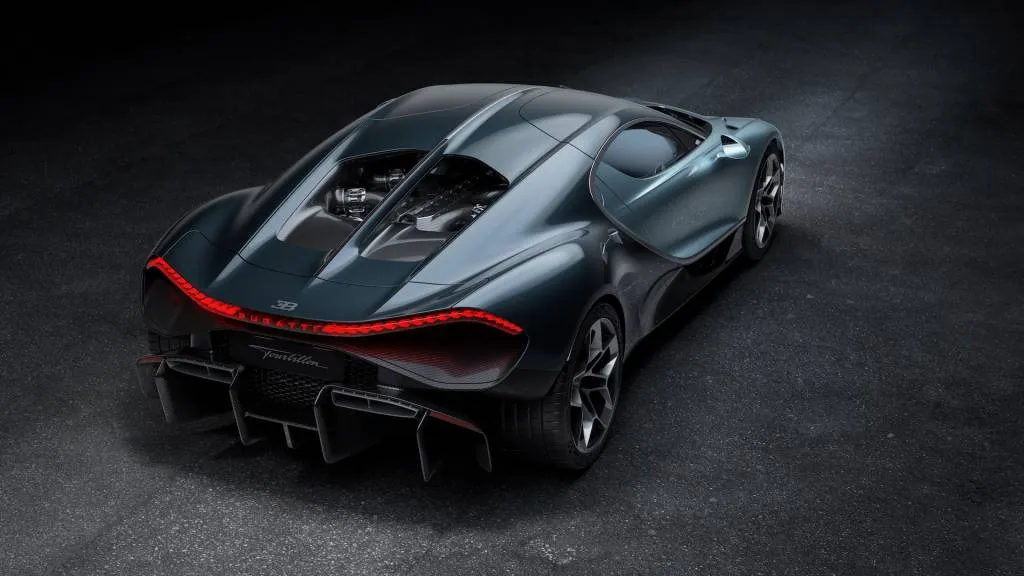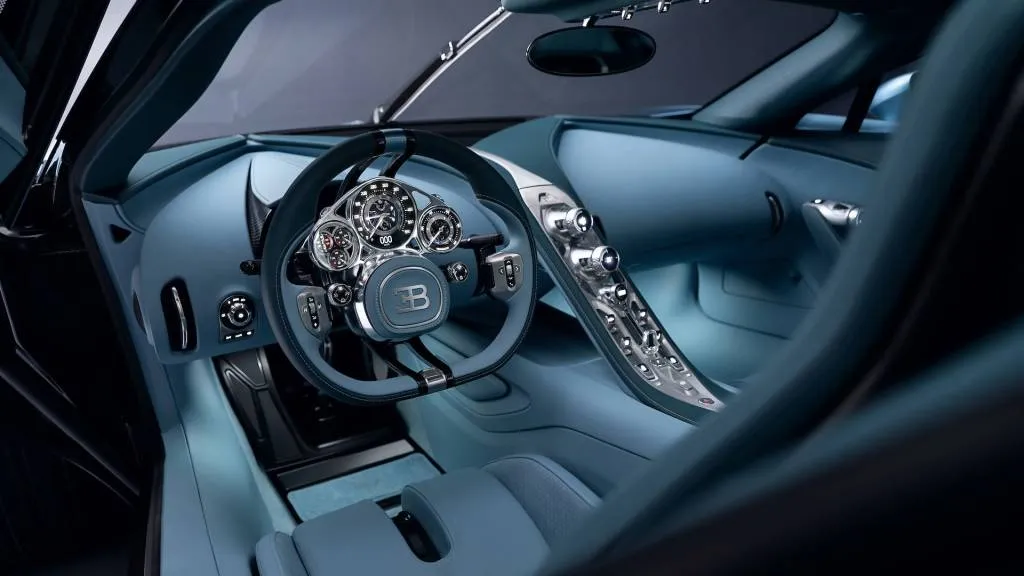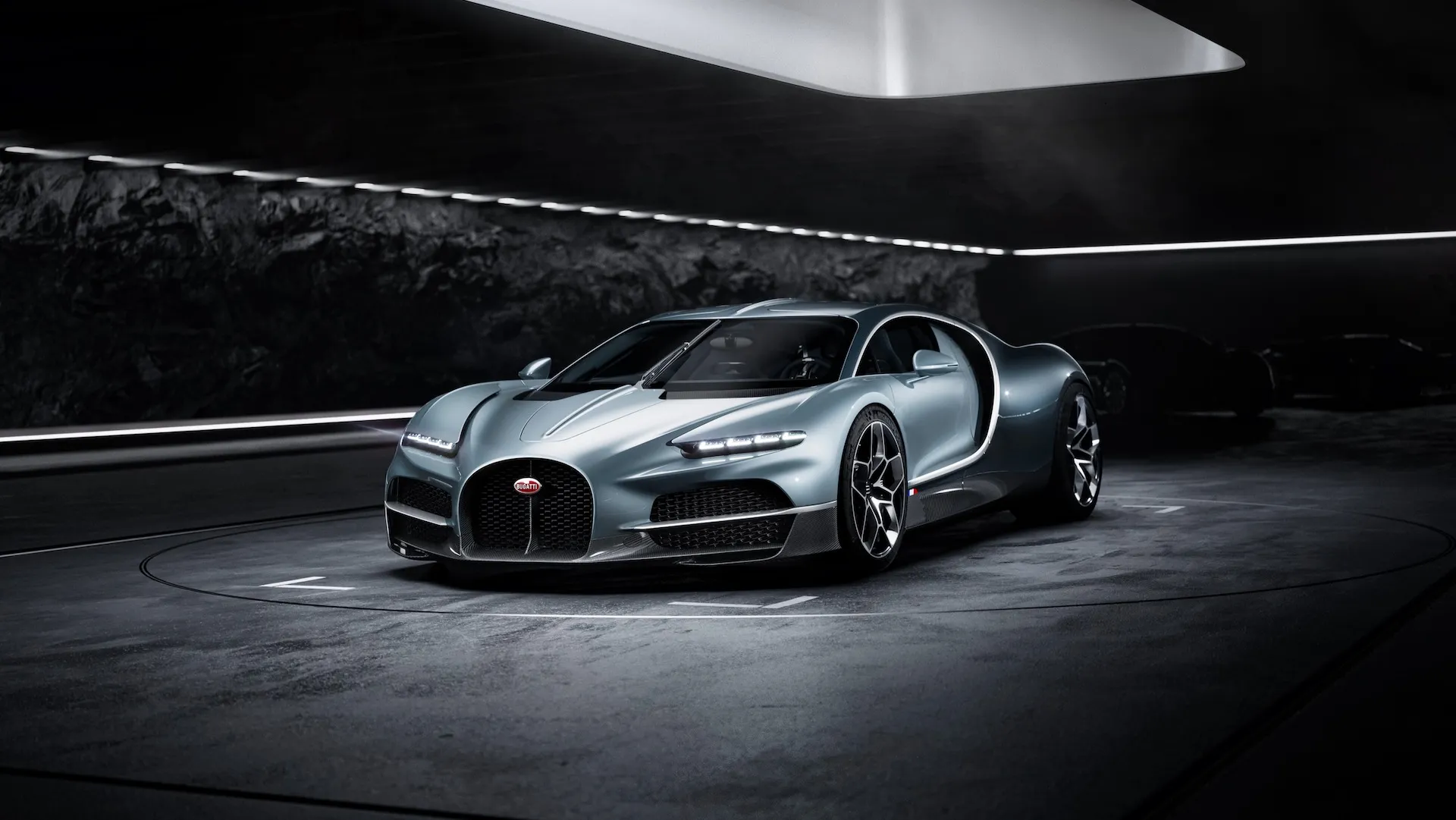- The Bugatti Tourbillon marks a new era for hypercars as it supersedes the Chiron
- Bugatti said the Tourbillon costs about $4 million
- The Tourbillon has a V-16 plug-in hybrid powertrain with 1,800 hp
Bugatti on Thursday unveiled the successor to the Chiron, a V-16-powered plug-in hybrid hypercar called the Tourbillon.
Instead of naming the new hypercar after a famous racing driver from Bugatti’s history, as with the Chiron and its predecessor, the Veyron, the Tourbillon gets its name from high-end watches. Like a fine watch, the Bugatti Tourbillon is a celebration of mechanical complexity, Mate Rimac, CEO of parent company Bugatti Rimac, said at the car’s reveal.
Production will be limited to 250 units, with deliveries scheduled to start in 2026 and pricing set at about $4 million. In the meantime, Bugatti will complete its remaining W-16 cars, including the Bolide track car and Mistral roadster.
This is the first Bugatti created under the stewardship of Rimac, also responsible for the Rimac Nevera and Concept_One electric supercars. But Rimac felt a Bugatti demanded the emotionality of an internal-combustion engine, so he commissioned a new naturally aspirated 8.3-liter V-16 to replace the quad-turbocharged 8.0-liter W-16 engines that were signature elements of the Chiron and Veyron.

Bugatti Tourbillon
The first production V-16 since the engine that powered the 1990s Cizeta V16T supercar, revs to 9,000 rpm and makes 1,000 hp by itself. It’s teamed with an 8-speed dual-clutch transmission and three electric motors (two at the front and one at the rear) that add 800 hp for a total of 1,800 hp with a broader power band than the naturally aspirated engine would be able to deliver by itself.
A structurally integral 25-kwh T-shaped battery pack sits in the center tunnel and behind the seats, affording what Bugatti claims will provide up to 37 miles of electric range, though it’s unclear if that’s on the more lenient European WLTP cycle or the more stringent U.S. EPA cycle. Even with the pack and motors, Rimac claims the Tourbillon is lighter than the Chiron (although he won’t say by how much). That was achieved in part with the use of 3D-printed components, including suspension pieces claimed to be 45% lighter than those used for the Chiron.
Bugatti estimates 0-62 mph acceleration in 2.0 seconds, 0-124 mph in less than 5.0 seconds, 0-186 mph in less than 10.0 seconds, and 0-248 mph in under 25.0 seconds. Acceleration finally stops at 276 mph.

Bugatti Tourbillon
While Bugatti claims the Tourbillon doesn’t share any components with the Chiron, its styling is evolutionary. The Bugatti horseshoe grille has been widened and sits farther forward, and its flanking intakes have gotten larger. The hoop-like element that houses the side air intakes remains, but now frames McLaren-style butterfly doors. The central spine inspired by the riveted halves of the Bugatti Type 57SC Atlantic returns as well. A larger rear diffuser means less reliance on the pop-up rear wing, and also doubles as a crash structure.
Despite the longer engine and the addition of a battery pack, Bugatti claims interior space is the same as the Chiron’s. The interior features an intricate mechanical gauge cluster made with help from Swiss watchmakers and comprised of more than 600 parts, including some made from titanium and gemstones. The center console is made from aluminum and specially designed crystal glass. A touchscreen deploys from the console only when needed.

These are truly impressive ideas in on the topic of blogging.
You have touched some nice factors here. Any way keep up wrinting.
ivermectin 6mg tablets – oral carbamazepine 200mg carbamazepine 200mg without prescription
isotretinoin 40mg sale – dexona brand order zyvox sale
buy generic amoxil over the counter – buy generic diovan 160mg buy ipratropium 100mcg sale
buy azithromycin 500mg pill – buy nebivolol 20mg for sale order bystolic for sale
order generic omnacortil 20mg – prometrium 100mg without prescription order generic progesterone 100mg
order furosemide 100mg generic – furosemide 40mg generic where to buy betnovate without a prescription
purchase amoxiclav for sale – order duloxetine for sale order duloxetine 20mg generic
cost doxycycline – glucotrol 10mg price glipizide 5mg cheap
order cialis 10mg online – buy sildenafil 100mg sale guaranteed viagra overnight delivery usa
sildenafil mail order us – order tadalafil 10mg pills order cialis 10mg online cheap
order atorvastatin 80mg generic – order generic amlodipine 5mg brand zestril
buy cenforce 50mg online cheap – cenforce 100mg sale glycomet 1000mg usa
where to buy atorvastatin without a prescription – buy generic norvasc 10mg buy zestril 10mg online
lipitor 20mg cost – purchase norvasc without prescription order prinivil online
order omeprazole 20mg pills – buy tenormin 50mg online cheap order atenolol generic
oral medrol – order triamcinolone 10mg pill aristocort 10mg brand
misoprostol online – order misoprostol without prescription order diltiazem pill
order acyclovir 400mg online cheap – order rosuvastatin 10mg order generic crestor
motilium pills – sumycin cheap cyclobenzaprine 15mg price
buy motilium for sale – purchase domperidone buy cyclobenzaprine medication
cost propranolol – methotrexate 5mg for sale order methotrexate 10mg without prescription
buy medex generic – cheap reglan 10mg buy generic cozaar online
buy generic levaquin for sale – brand ranitidine cost ranitidine 300mg
order generic nexium 20mg – buy generic esomeprazole imitrex us
meloxicam canada – order celebrex sale buy flomax generic
zofran where to buy – buy spironolactone pill simvastatin 10mg us
valtrex usa – buy diflucan brand forcan
provigil price buy generic provigil 100mg buy modafinil pills for sale buy modafinil 100mg pill buy cheap modafinil modafinil 200mg cost provigil pill
This website positively has all of the information and facts I needed about this participant and didn’t know who to ask.
I couldn’t resist commenting. Profoundly written!